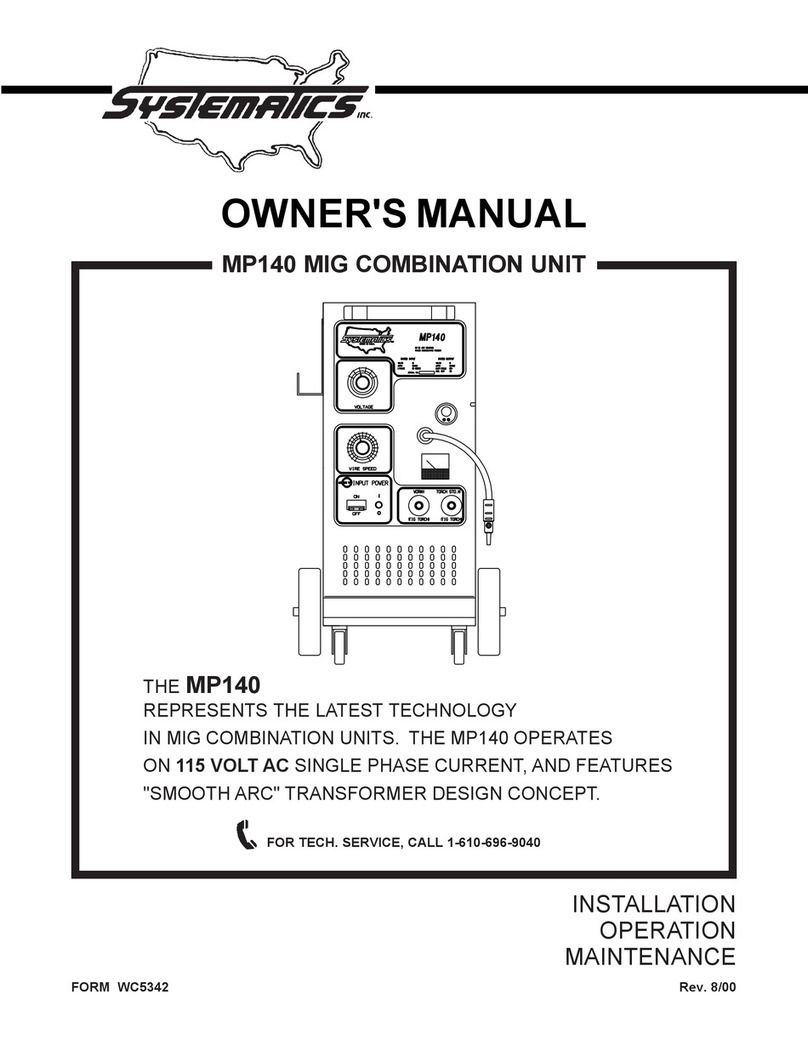
Systematics, Inc. West Chester, PA. 19380
MANUFACTURER’S LIMITED WARRANTY
This equipment is warranted against defects in materials
and workmanship for a period of two years from the date of
purchase.
EXCEPTION: THE MIG TORCH IS WARRANTED FOR A
PERIOD OF 30 DAYS FROM THE DATE OF PURCHASE.
Should the equipment become defective for such reason,
the Manufacturer will repair it without charge, if it is returned
to the Manufacturer’s factory, freight prepaid. This warranty
does not cover: (1) failure due to normal wear and tear; (2)
consumable parts, such as, but not limited to, torch contact
tips, gas cups and insulating bushings; (3) damage by
accident, force majeure, improper use, neglect, unauthor-
ized repair or alteration; (4) anyone other than the original
purchaser.
THIS LIMITED WARRANTY IS IN LIEU OF ALL OTHER
WARRANTIES, EXPRESS OR IMPLIED. THE MANUFAC-
TURER SHALL NOT BE LIABLE FOR ANY INJURY TO
PERSONS, INCLUDING DEATH; OR LOSS OR DAMAGE
TO ANY PROPERTY, DIRECT OR CONSEQUENTIAL,
INCLUDING, BUT NOT LIMITED TO, LOSS OF USE,
ARISING OUT OF THE USE, OR THE INABILITY TO USE,
THE PRODUCT. THE USER ASSUMES ALL RISK AND
LIABILITY WHATSOEVER IN CONNECTION WITH THE
USE OF THE PRODUCT, AND BEFORE DOING SO,
SHALL DETERMINE ITS SUITABILITY FOR HIS IN-
TENDED USE, AND SHALL ASCERTAIN THE PROPER
METHOD OF USING IT.
SOME STATES DO NOT ALLOW LIMITATIONS ON
HOW LONG AN IMPLIED WARRANTY LASTS, OR THE
EXCLUSIONS OR LIMITATIONS OF INCIDENTAL OR
CONSEQUENTIAL DAMAGES. SO THE ABOVE LIMITA-
TIONS OR EXCLUSIONS MAY NOT APPLY TO YOU. THIS
WARRANTY GIVES YOU SPECIFIC LEGAL RIGHTS, AND
YOU MAY HAVE OTHER RIGHTS WHICH MAY VARY
FROM STATE TO STATE.
ARC WELDING CAN BE INJURIOUS TO OPERA-
TOR AND PERSONS IN THE WORK AREA -——
CONSULT INSTRUCTION MANUAL BEFORE
OPERATING.
ELECTRIC SHOCK can kill.
•Do not touch electrodes or other electrically live parts.
•Insulate yourself from work and ground.
•Install and ground machine in accordance with the National
Electical Code and local code(s). Read Operating Manual
before installing or operating.
•Do not operate with protective covers, panels, or guard
removed.
•Disconnect input power before servicing.
•Only qualified personnel should install, use, or service this
equipment.
ARC RAYS can injure your eyes and burn
skin.
•Wear correct eye, ear, and body protection while welding.
FUMES AND GASES can be dangerous to your
health.
•Use enough ventilation and/or exhaust at the arc.
•Keep your head out of fumes.
•Do not breathe fumes.
READ AND UNDERSTAND THE
MANUFACTURER’S INSTRUCTIONS AND
YOUR EMPLOYER’S SAFETY PRACTICES.
See American National Standard Z49.1, “Safety in
Welding and Cutting”, published by the American
Welding Society, 2501 N.W. 7th St., Miami, Florida
33125; OSHA Safety and Health Standards, 29 CFR
1910 available from U.S. Dept. of Labor, Wash.,
D.C. 20210.
!WARNING
TABLE OF CONTENTS
INTRODUCTION ........................................................................... 1
DESCRIPTION, SPECIFICATIONS .............................................. 2
CHECK LIST (CONTENTS) .......................................................... 3
INSTALLATION & ELECTRICAL REQUIREMENTS .................... 3
OPERATION ................................................................................. 7
MAINTENANCE .......................................................................... 12
TROUBLE SHOOTING CHART .................................................. 14
CONNECTING TIG PACK OR SPOOL GUN ............................. 19
LINER INSTALLATION ............................................................... 20
PARTS BREAKDOWN - MIG TORCH ........................................ 21
OPTIONS - TIG PACK OR SPOOL GUN ................................... 23




























